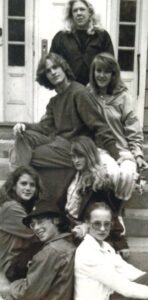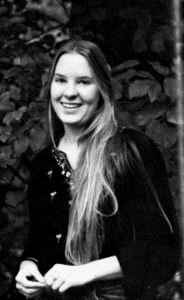Ellie Fabe ’78
I started at Lotspeich in preschool and continued on to Hillsdale — I was in ninth grade at the time of the merger and went all the way through, but we didn’t have the term “lifer,” which is more recent.
In kindergarten, my teacher’s husband set up a carpentry workbench in our classroom, so when we arrived at school, we could hammer and saw things before the day got going. This was the 1960s — we had a lot of freedom, and nobody seemed to be very worried about anyone sawing their hand off. Later, as older kids, we were allowed to walk wherever we wanted. We were very untethered.

The campus was more of a farm campus then. A pony lived on campus in a little enclosed yard next to the Clothing Exchange. There were fewer buildings, more trees, and the campus felt more spacious. The big hill, which leads down to the turf athletic fields now, back then was like the wilderness to us. At the top of the hill, behind the Pavilion, was the displaced mud leftover from when they built I-71, and we called it “the Rock Pile.” We were allowed to go there at recess, or whenever we were free, to hunt for fossils, especially in fourth grade when we studied them in science.
Lotspeich was a really creative place, maybe even in unintentional ways. There was this ritual where we each designed and made an elaborate cake for Valentine’s Day — it was sort of like sculpture class with cake as the medium. Then you gave it to somebody else, and somebody else gave their cake to you. After I graduated from Seven Hills and went to art school, I had an assignment to create a three-dimensional object out of food, and I was like, “Oh my god, it’s the Lotspeich fifth grade baking extravaganza all over again!” There were a lot of fun activities that were very fueling of the creative process.

When the schools merged, the way they explained it to us was that CPS and Hillsdale couldn’t make it alone if we didn’t combine. For the decision-makers, merging was the pragmatic thing to do, but I don’t think they had a true sense of what it felt like for the kids. I remember being in ninth grade, and the school had to bring in a psychologist because the seniors were so shellshocked they couldn’t get along. The school did try to have students participate in things like deciding the new logo and the name of the new merged school and even things like the school colors. The green and gold came from Hillsdale and the blue and white came from CPS — those things felt important to us.

In high school, I spent a lot of time in Hill Manor. Seven Hills has always done a good job of providing sanctuaries within the school — the places you could go if you were having a bad day or just wanted to get away. For me, that was the art room with Chris Hayward and also to Patty Flannigan’s theater classroom. Both of those teachers were always on our side, the students’ side. And they actually were our friends and made us feel respected and like what we were doing was significant.

Years later, before my own kids started at Seven Hills, I went back to see one of my nephews in the school talent show. That night there were some incredible student musicians, ones who were obviously very cool, followed by a girl who was singing a song that was a little more on the shaky side, and yet they both got the same huge encouraging response from the audience — whistling and raucous applause. I remember thinking, “Wow, how fantastic is that?” I liked that the school had doubled down on and codified a culture of kindness. You can’t make kids be nice, and not everybody is, but when it becomes part of the culture — what parent wouldn’t want that?
When my two boys, Georgie and Reed, started there, the school had evolved. I mean, when I was in seventh grade there was a senior smoking lounge. So, that’s probably a good change. Still, I miss the rough edges sometimes. I miss Hill Manor. But I think Seven Hills has done a good job staying strong in the arts while bringing athletics up to speed. By the time Georgie and Reed were there, the school had really pumped up its athletics. In the 1970s, when Hillsdale first began admitting boys, there were so few that they all had to play on every team — and Country Day was always wiping the floor with us.
As a Seven Hills parent, old friends who knew me as a teenager would be like, “You, Ellie Fabe, the arts-music-theater girl, have a sporty son?” And I did have a sporty son, who went on to play college lacrosse. So, that changed my perspective a little. I was a person who mourned the covering of the field with AstroTurf, but I could see that a lot of boys don’t want to go to a school if it’s not competitive in sports.
One of the most important constants has been the way the school values and nurtures curiosity. I used to tell Georgie and Reed that if you hit age 40 and you have an idea you’re excited about, often the world isn’t really that interested in hearing about it. But if you’re 15-years-old at Seven Hills and there’s something you’d like to do or create or explore, and you tell your teacher, they’ll do anything to support you and make it happen.

